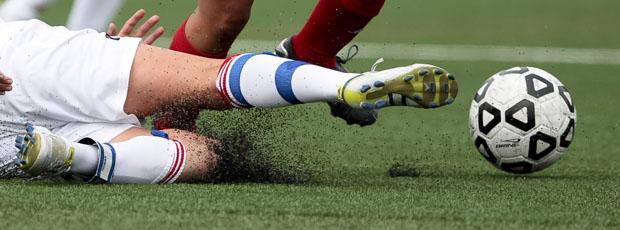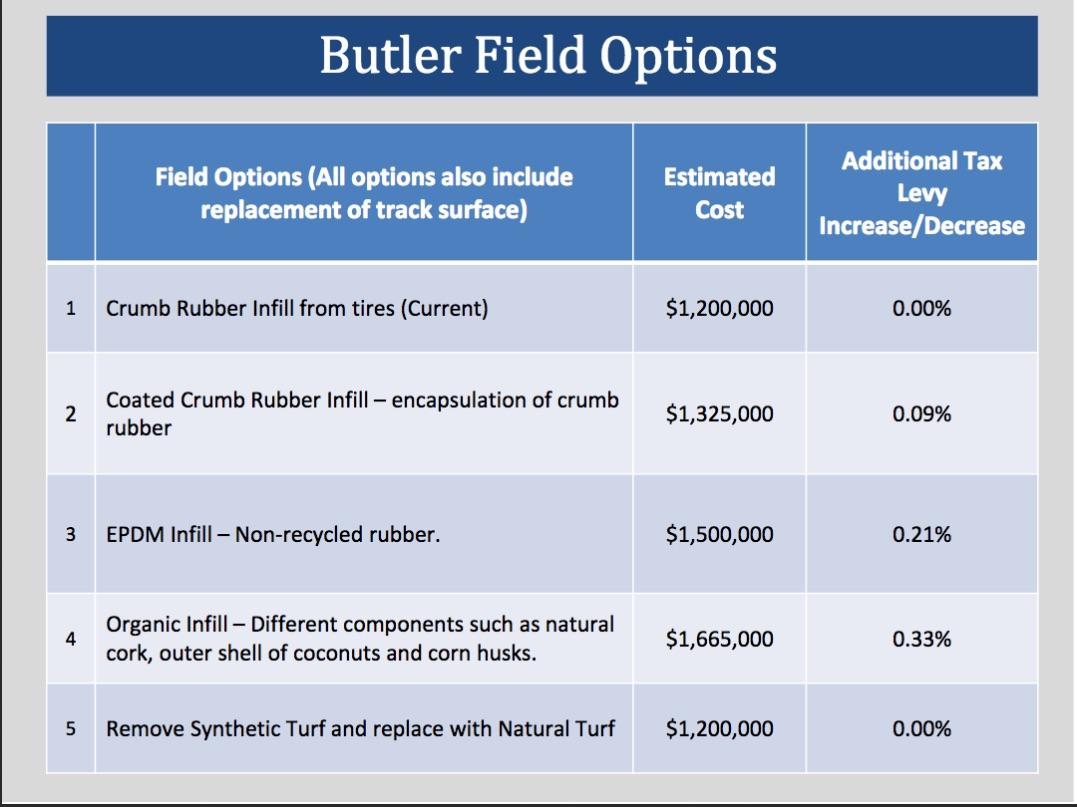Butler Field Turf Debate: BOE Schedules Info Session for April 10
- Tuesday, 27 March 2018 19:42
- Last Updated: Wednesday, 28 March 2018 18:34
- Published: Tuesday, 27 March 2018 19:42
- Laura Halligan
- Hits: 6274
 Turf fields are under debate At the beginning of this year’s school budget process, renovating Butler Field seemed like a relatively routine facilities project. It was a top priority for the district due to its aging synthetic turf and the only question was how much to allocate for the work, based on a number of seemingly straightforward options.
Turf fields are under debate At the beginning of this year’s school budget process, renovating Butler Field seemed like a relatively routine facilities project. It was a top priority for the district due to its aging synthetic turf and the only question was how much to allocate for the work, based on a number of seemingly straightforward options.
Fast forward to recent budget forums, where board of education members, residents and school administrators discovered that the choice of which turf to install was more complicated than expected.
In fact, last week’s session raised more questions than answers about the renovation, and the board has decided to collect more information about turf materials, and their related costs and benefits before making a decision about how much should be allocated for the project. It will meet again on Tuesday, April 10, at 6:00 pm to further discuss the issue and hear residents’ opinions in an effort to create a plan prior to adopting a final 2018-19 budget on April 16.
The current draft budget includes $1,200,000 to replace the field and track surface; and suggests the use of crumb rubber infill, made from recycled tires, to provide bounce and cushioning. Assistant Superintendent for Business and Facilities Stuart Mattey explained that crumb rubber was used previously and was simply a rollover from past construction. It commonly is installed in many districts and while there are many differing opinions about the environmental impact of such material, but that the “jury is out” on these effects.
Other options include using coated crumb rubber infill (which reduces dust); EPDM infill, made from non-recycled rubber; organic infill, which includes natural cork, coconut shells and cornhusks; or, natural turf. All of these options, save natural grass, would be more costly to install and result in an increased tax levy for residents. The estimated increases range from $125,000 to $465,000 (or 0.09 percent to 0.33 percent in tax levy).
After presenting the various field options, Mattey stated that while administrators had an idea of what material would be used, they wanted to research the issue a bit more, but were sensitive to the budget timeline and wanted direction from the board on how best to proceed. Board of Education President Bill Natbony responded, “I think as a board, we’re going to have questions… we’d also like to hear from the public… recognizing that we’re not going to make a decision tonight. From a budgetary standpoint, there’s only $1.2 million currently in the budget… and we see a $1.2 to a $1.665 potential cost there.”
Hold on a Minute…
When residents were invited to discuss the draft budget, two raised concerns about the plan for Butler Field. Susan Lee Foley (Brown Road), Scarsdale PT Council Budget Study co-chair, said, “The Butler Field… renovation (has) safety implications. In last week’s budget forum… two community members expressed deep concerns about synthetic turf and rubber crumb fields… We hope that the district and the board will make every effort to make the most informed and data-driven decision about the type of materials to be used to replace the existing field.”
Michelle Sterling (Brighton Road) stated, “Bottom line, toxic tire scraps do not belong on our children’s playing fields… It is absolutely antithetical to the health and safety and wellness, which I know you all are concerned with, of our kids to put an artificial turf with ground up tires on our field.” She continued, “We know now that it offgases… it gets ingested; it goes onto abrasions. It’s been particularly bad for soccer players and soccer goalies -- people who slide on the field.” Sterling also mentioned that, “Both the Consumer Product Safety Commission and the US EPA have withdrawn their safety assurances for recycled rubber tire products (and) the EPA has posted new cautions concerning unexplored chemical exposure to more 30 compounds found in synthetic tire turf.”
She acknowledged the desire to install synthetic turf by saying, “It absolutely extends the season… and the playing day. That’s a real, positive benefit. It is up to you guys to really weigh the safety and health and wellness of our kids versus a few extra games in a season and a little extra playing time in a day. “
Sterling then went on to note specific negative environmental impacts of artificial turf and emphasized that it is not maintenance-free, requiring watering and disinfecting, and questioned the district’s cost estimations for installation of a natural turf field, which also has been set at $1.2 million. “No where have I seen that putting down sod is equal to putting down artificial turf. It is always significantly cheaper to put down sod. Those numbers do not make sense, so what we really need to see is a breakout,” she said.
Members of the board continued the Butler Field discussion, with a focus on its implications for this year’s budget process. Board Member Art Rublin addressed the pending April budget deadline and new these new concerns about field materials. “We did talk about the possibility of adding a meeting… between March 19 and April 16. This, to me, is a significant issue and I think… we might continue the discussion,” he said.
Board of Education Vice President Scott Silberfein followed, “I don’t think anyone at this table wants to put crumb rubber infill from tires on the field… (This) means we’re at a minimum of $1.3 million unless we go with natural turf… I probably would be in favor of continuing to use a synthetic turf, but I’d certainly like to hear more and see what the recommendations are. I would be leaning that way, but not (towards) a crumb rubber infill.”
Natbony continued, “I’m very concerned about using rubber products on the field… when I look at the options, I’m looking at it from a budgeting perspective... You’ve got this $400,000 potential difference here… If we decide to go the synthetic route, where do we get that $400,000?”
Board Member Leila Maude explained her view, “… No one’s writing to us saying, ‘Please put down a synthetic turf.’ … All my education (on the issue) is coming from the people who are coming here and speaking… If this is a decision that we have to (make) in the next four weeks… as an individual, I’m going to say please not use artificial turf.”
Board Member Nina Cannon said, “I think this meeting has been eye-opening… In the interest of education, I’m open but, so far, all I’ve heard is everything telling me why I should not put another synthetic turf in that place.” Board Member Pam Fuehrer echoed the sentiment, “ I want to see what we can do with a grass surface… We talk about the toxicity… and the disposal of the existing field, from a sustainability issue, is pretty egregious. Rublin concurred, but wanted to learn more. “My leaning right now, is with (Maude, Cannon and Fuehrer). I would like to hear from… others about the benefits of artificial turf… and, also, the downsides of grass. Right now, my leaning is toward the grass. I really am open to hearing otherwise.”
Scarsdale Schools Superintendent Thomas Hagerman cautioned the board about moving too quickly on the matter, stating, “We have had this artificially surfaced field for more than a decade and have heard, virtually, zero about it until the last two weeks. And, certainly it has come out as a very significant issue… There’s lots of information (and issues)… and people are going to have very passionate views about these issues… I caution that moving too quickly is going to cause this to be a very reactive process that could pit groups with different interests against other groups.” He later continued, “We really need to understand all the interests in this space are and have a plan moving forward… we need to understand the community’s needs and desires, even more so than the research, although that plays into it.”
Board members quickly came to the realization that the process may take longer than the month left before April 16. They debated the merits of postponing the work another year to allow for more review and allocating the maximum estimated cost of renovation to provide for any circumstance. They also discussed concerns about balancing potential increased costs, a need to know more and their commitment to renovate Butler Field as a priority one project. Unable to reach a consensus on how to proceed, the board agreed to leave the existing $1.2 million allocation for renovation in the budget and schedule another meeting to collect community input and additional information about materials options. Interested residents are urged to provide the board with their comments and concerns at the upcoming meeting on April 10 or before then via email.













